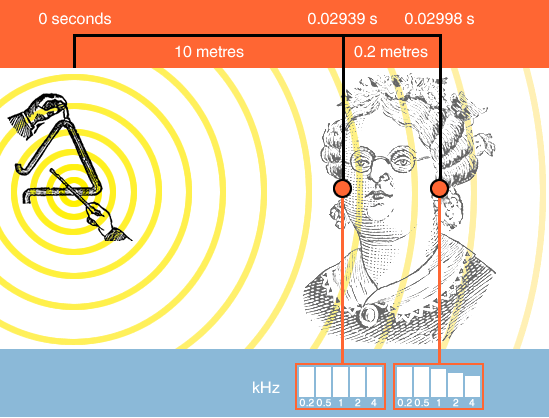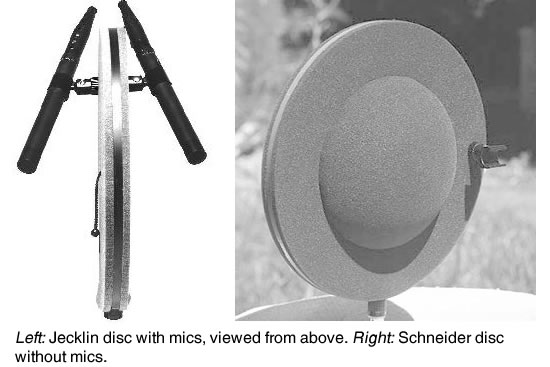Blog
Occasional posts on subjects including field recording, London history and literature, other websites worth looking at, articles in the press, and news of sound-related events.
Building a field recording system 4: introduction to binaural sound recording
EARLIER POSTS IN the series on building your own field recording system have discussed pocket-sized recorders and the best accessories to get for them. Here we’ll begin looking beyond the recorder’s built-in mics towards using external mics that plug into the recorder.
By doing this you’ll greatly expand the range of situations and environments in which you can make satisfying recordings. One of the simplest and cheapest steps along this path is binaural stereo recording.
‘Binaural’ is an unfamiliar term to many people, and occasionally a few recordists latch onto this by implying that they’re using a rare and esoteric technology. It’s like how packets of cheap biscuits have smothered in real chocolate! printed on them, as if chocolate can only be made by distilling the tears of cave-dwelling bats from a remote part of Borneo.
In brief, binaural recording involves placing a tiny omnidirectional mic in each of your ears or in the ears of a carefully-crafted dummy head. The results can be very impressive, with lifelike stereo images in which the sounds really seem to come from clearly-defined locations. The drawback of binaural stereo is that the effect of realism only works when the listener is using headphones.
A later post will look at the various makes of binaural mics on offer and their relative merits. What I’ll do here is provide an overview of how different stereo recording setups try to create the illusion of ‘being there’ on playback, culminating in binaural sound. To keep on track, here’s an example of a binaural recording made by an East Anglian field recordist who goes under the contributor name of ermine on Audioboo:
THE PHANTOM IMAGE
Stereo sound involves an auditory illusion known as a phantom image. Differences between the channels played by a pair of speakers trick the listener’s brain into constructing the perception of a continuous soundfield curving in from the sides, not just sound emanating from two fixed points.
The experience of this illusion of spatial sound was once considered exciting enough for Count Basie to perform the song Stereophonic, and for Cole Porter to write Stereophonic Sound for Fred Astaire and Cyd Charisse in 1957:
If Ava Gardner played Godiva riding on a mare
the people wouldn’t pay a cent to see her in the bare
unless she had glorious Technicolor, Cinecolor
or Warnercolor or Pathecolor or Eastmancolor
or Kodacolor or any color
and stereophonic sound
and stereophonic as an extra tonic
stereophonic sound
There are three inter-channel differences which may be involved in stereo recording and reproduction. In everyday life our sense of hearing uses all of them as cues to locate where sounds are coming from, only they’re referred to as interaural differences, meaning the differences in sound reaching each ear.
The first consists of simple differences in sound intensity in each stereo channel, or in the sound reaching each ear. The second involves the miniscule time delay between sound waves from an off-centre source reaching one ear and then the other.
The third involves changes in the spectrum of frequencies reaching each ear. These changes are caused by the mass and size of the head, by parts of the upper body, and by the shape of the outer parts of the ears.
The diagram below illustrates all three differences in action:

We’re aware of off-centre sounds being louder in one ear than another. But interaural differences in time of arrival are processed by our brains in a fast and automatic way below the level of conscious experience.
Assuming our listener is at sea level and the air is at room temperature, a sound from one side will reach the facing ear around 0.6 milliseconds before reaching the other ear, due to the 20-odd centimetre gap between the two. That the brain can detect such a brief delay is particularly impressive considering how the fastest nerve signals are propagated at only a third of the speed of sound.
When there’s a difference between the spectrum of frequencies reaching each ear, that too is processed under the radar screen of consciousness. In the diagram above, the listener’s ear facing away from the sound source receives a pattern where the higher frequencies have been attenuated. This is because the size and mass of her head have created an acoustic shadow.
Low-frequency sounds have longer wavelengths which can pass around her head unimpeded, but high-frequency sounds have much shorter wavelengths so they’re partially blocked and filtered. Frequency differences start to become an especially important cue for sound localisation where wavelengths are shorter than the 20 centimetre-odd diameter of the human head, which is from around 1.6 kilohertz upwards.
There are various ways of setting up mics to record in stereo. Some techniques use inter-channel differences in loudness or sound intensity alone. Others place two directional mics at an angle to one another and with a gap between them ranging from around 17 cm to 30cm. This captures differences in sound intensity and time of arrival between the mics from off-centre sound sources.
Recordings with the most realistic-sounding stereo images use all three cues of intensity, time of arrival, and the spectrum of frequencies. In this way they try to get close to how our sense of hearing detects where sounds are coming from. Such techniques include placing an obstacle or baffle between two mics, and binaural recording where two mics are placed in the ears of the recordist or in the ears of dummy head.
BAFFLED BY ACOUSTICS
Early experiments in trying to exploit all three cues of intensity, time lag and frequency changes were carried out in the 1930s by the brilliant British engineer Alan Blumlein. Among Blumlein’s first stereo recordings are ones which were described as involving a baffle set between the two mics. Unfortunately, we don’t know what the baffle was exactly. But his landmark patent from 1931, Improvements in and relating to Sound-transmission, Sound-recording and Sound-reproducing Systems, refers to a ‘block of wood’.
You may know someone for whom a block of wood seems a likely substitute for their head in casting the necessary acoustic shadow. A later form of baffle didn’t resemble a head at all. In the 1980s Jürg Jecklin, a Swiss-based radio sound engineer, developed a system he termed Optimum Stereo Signal with a disc-shaped baffle.
It’s now generally referred to as a Jecklin disc, and you can see a photograph of one below next to a Schneider disc, which returns to a vaguely head-like form with its central spherical bulge. Both are sold by the US-based firm Core Sound, on whose website I found the pictures.

The most realistic head-like baffle has to be, well, a head. Although a human head weighs around seven or eight pounds (it says here), you don’t have to carry your head around in a bag like you would a Jecklin disc. How easy is that? There are drawbacks to attaching a microphone to each side of your bonce, including having to keep very still, breathing quietly, and looking weird. But it’s a technique which has been used for the large majority of recordings here on the London Sound Survey and it can work well within certain limits.
Wearing microphones on your head doesn’t necessarily involve putting them in your ears, and therefore not all headworn microphone techniques are binaural. The American sound engineer Lenny Lombardo took out a patent in 1989 for a recording technique he terms dimensional stereo. Since then he’s been making and selling a range of dimensional stereo mics through his Sonic Studios business, and it was a pair of them which got me started in field recording.
Sonic Studios mics typically come fixed inside a windshield headband. At each side of the headband is a bulbous cage made from stiff wire, over which is stretched an acoustically-transparent fabric. The mics are permanently mounted inside each bulb. Here’s a photograph of the sound recordist and anthropologist Steven Feld at work with his Sonic Studios mics in their windshield-headband. Note how he’s wearing them in the recommended position so the mics are just before his ears.

Larger mics than the Sonic Studios ones can also be headworn. I wear my two DPA 2006C mics by attaching them to a Beyerdynamic headband with a pair of plumber’s jubilee clips. But apart from the obvious fact that mics of that size won’t fit in anyone’s ears, how are techniques like Lombardo’s dimensional stereo different to binaural stereo?
IN-EAR BINAURAL SOUND
Below is one of a pair of low-cost Sound Professionals binaural mics lodged inside an ear. The mic really is tiny, and it’s kept in place by a piece of flexible, translucent plastic.

In that position, the microphone can record directionally-dependent changes in frequency. But these don’t just occur because of the acoustic shadow cast by the head. There are also subtle forms of focusing and filtering caused by the convoluted shape of the outer ear or pinna.
Many mammals have funnel-shaped pinnae which they can turn independently of one another to help localise sound sources. Humans, along with the rest of the great apes, can’t do this and instead we’ve evolved fixed-position ears with a complex shape. Their lack of symmetry makes sense as an adaptation providing an extra layer of directionally-dependent sound filtering.
Here’s a simple test I carried out with a pair of Sound Professionals mics first worn binaurally as intended, and then positioned at my temples by attaching them to a hairband. I made up a sound file consisting of white noise and played it through my computer’s speakers while sat facing them and recording.

The spectrogram plots show no obvious differences up to about 1.5 kHz. Between there and 7 kHz the in-ear binaural position seems slightly more responsive, and there are marked contrasts above 7 kHz. This doesn’t tell you anything about the precise nature of the directional effects, but it does show that our outer ears help selectively shape high-frequency sounds.
The contrast between the two spectograms also suggests that the localisation effects of binaural recording may be perceived best by younger listeners who can usually hear higher frequencies than those of us who can only look forward to a cheap pint in a Wetherspoon’s. Perhaps this is why the Virtual Barbershop binaural recording on YouTube has attracted plenty of coarsely appreciative comments and over 12 million views, far more than any other audio-plus-static-title upload you’re likely to come across.
Binaural sound recording captures this accentuation of inter-ear differences, but it is that very specificity which limits the realism of such recordings to headphone playback only. The left and right channels need to be kept separate so that the brain can receive the correct localisation cues for each ear without interference or crosstalk from the other channel. This separation isn’t possible when a binaural recording is heard playing over loudspeakers. The vivid impression of being there is lost.
The dimensional stereo technique, which is referred to as ‘headworn stereo’ thoughout this site, avoids such problems by accepting a trade-off. The resulting stereo image isn’t as realistic as a binaural recording heard over headphones, but it performs better over loudspeakers. About three or four years ago I posted some poll questions on a few internet forums asking people how they listened to audio they found online. A majority said they used either external computer speakers or built-in laptop speakers. Not going down the binaural route seemed the sensible thing to do.
Nowadays the situation is less clear-cut. Many more people now listen to internet audio using smartphones, iPads and similar Fisher-Price activity centres for grown-ups, and they’ll typically do so while using earbuds or headphones. Whether you find that world appealing or not, the relatively low cost of binaural mic sets invites experimentation.
AND FINALLY . . .
The next post in this series will compare some of the better-known makes of binaural mics. But I’ll leave you with a glimpse of a remarkable set of not-quite-binaural mics made by the Japanese firm Otokinoko, whose name means sound mushroom. Less impressive than the football-kicking Asimo robot, but certainly more wholesome than manga comics showing lustful hyper-intelligent octopi up to no good, these mics testify to the playfulness of Japanese product design:

The price tag is, unfortunately, deadly serious at around £3,000.
ABOUT SOUND
FIELD RECORDINGS
The balloonist in the desert is dreaming
The Binaural Diaries of Ollie Hall
GEOGRAPHY AND WANDERINGS
The Ragged Society of Antiquarian Ramblers
LONDON
ORGANISATIONS
Midwest Society for Acoustic Ecology
World Forum for Acoustic Ecology